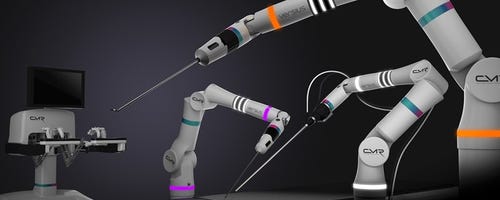Surgical Robotics Newcomer Explores Universal Robot Concept
December 13, 2016
Cambridge Medical Robotics's Versius can be used to perform colorectal, pelvic, and upper abdominal procedures.
Amanda Pedersen

The Versius system features light-weight robotic arms and
5-mm instruments.
A new venture-backed company that wants to add a touch of versatility and dexterity to the surgical robotics space said its Versius system performed "exactly as expected" in an initial round of cadaveric trials. Cambridge Medical Robotics Ltd. (CMR) said 32 surgeons have given the system a test run so far in 11 usability studies conducted in October and November.
Luke Hares, technology director of the Cambridge, England-based company, said the studies validated the universal surgical robot concept that CMR has been developing using a number of robotic arms in a flexible, modular system. The idea, Hares said, is to provide the "versatility and dexterity necessary to support the majority of laparoscopic procedures."
The Versius system is comprised of a surgeon console, light-weight robotic arms, and a range of wristed 5-mm instruments, according to CMR. The technology also uses 3-D high-definition imagery and is designed to incorporate force feedback to provide surgeons with life-like sensitivity.
Backed by ABB Technology Ventures, LGT Global, Cambridge Innovation Capital, and Escala Capital, the firm joins a number of other companies that are developing a new generation of surgical robots aimed at overcoming key limitations of current robotics technology such as size and expense. To date, the field has primarily been dominated by Intuitive Surgical, which sells the da Vinci system.
Mark Slack, CMR's medical director, said the first round of trials confirmed the ability of the system to perform surgery in the upper abdomen, and for colorectal and pelvic surgery. The next phase of development will include a study of individual operations to further assess the capability of the system and the performance of the graspers, scissors, electrocautery, and needle drivers, he said.
"We will continue with a series of studies to further assess and perfect the system while also exploring new operations previously difficult to perform with robotic surgery," Slack said.
Amanda Pedersen is Qmed's news editor. Reach her at [email protected].
[image courtesy of CAMBRIDGE MEDICAL ROBOTICS]
About the Author(s)
You May Also Like

.png?width=300&auto=webp&quality=80&disable=upscale)